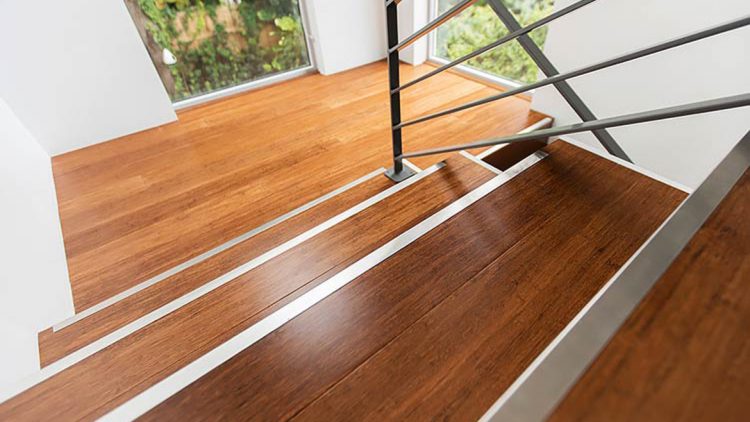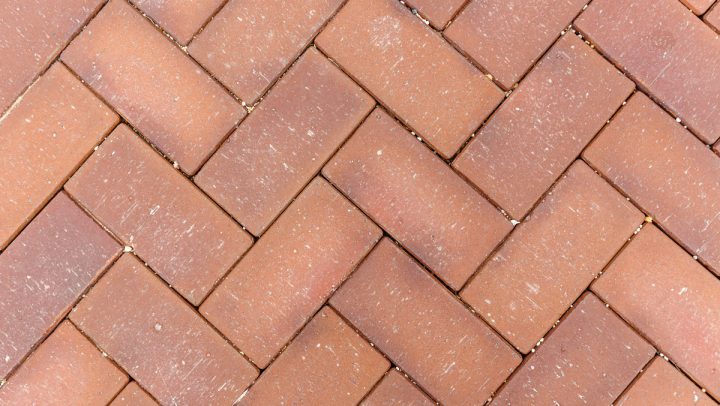Various flooring materials age at different rates and in different ways. Vinyl composition tile, for example, requires periodic refinishing and quickly loses its surface quality. Natural stone flooring, on the other hand, matures gently and can last for generations, as many historical examples demonstrate. While some estimates put the lifespan of flooring at 50 years, the National Association of Home Builders thinks that natural stone, especially granite, marble, and slate, can endure up to 100 years with adequate care.
Though natural stone flooring will outlast a building, its useful life does not have to end there. Natural stone’s longevity makes it a perfect material for reclamation and reuse in a range of applications; for ideas, see the National Stone Council’s case study on the use of salvaged stone. (Be sure to evaluate the stone as you would for virgin material before using it in a structural project.) This capability results in cost reductions not just in terms of installation but also in terms of environmental expenditures. When stone is given a second life, it saves energy, water, and materials that would otherwise be used in its extraction and processing.
Repair & Maintenance
Unlike vinyl flooring, coated concrete, or ceramic tile, natural stone has a consistent color and structure throughout. Surface scratches and damage are less visible with this integrated finish. Integral finishes are more easily repaired and consequently have a much longer lifespan than surface finishes. This feature, when combined with its durability, contributes to a minimal maintenance and repair profile for the product. However, due to foot activity and grime, natural stone installed in high-traffic areas may gradually fade. To remove the abrasive forces that cause dulling, stone floors merely need to be swept or cleaned on a regular basis. To prevent abrasive particles from entering the building, entry mats are recommended. Chemical solutions can be used to clean stone floors more thoroughly if necessary; contact your stone provider for a suitable product. In circumstances demanding high-gloss finishes, such a basic maintenance program will significantly reduce the requirement for polishing.
The Life-Cycle Cost is the price paid over the course of a person
Stone flooring’s somewhat high material and installation costs may prevent some designers from investigating it further. Natural stone, on the other hand, is cost-effective due to its long useful life and low maintenance requirements. Although high-quality stone, such as marble and Turkish travertine, have installation costs of $21/ft2 and $12.50/ft2, respectively (as opposed to under $10/ft2 for most other products), their annual expenses are less than those of some competing materials, according to a life-cycle cost (LCC) study commissioned by the Tile Council of North America. Sheet vinyl and vinyl composition tile (VCT) are more than twice as expensive as travertine or marble.
Air Quality in the Home
Due to the creation of dust, allergens, and volatile organic compounds (VOCs), several flooring products may contribute to poor indoor air quality. Dust and allergens can cause respiratory, cutaneous, and ocular discomfort, while VOCs can cause everything from headaches to respiratory irritation, and some are suspected or proven carcinogens.
Volatile organic compounds found in flooring are more often connected with the products used in its manufacture, installation, and maintenance or refurbishment than with the flooring itself. Adhesives, such as those used on carpet padding and tile, and chemical finishes, such as polyurethane for hardwood, are examples of such items. Even with frequent cleaning, carpet harbors particles that may be allergens or transmit bacteria, and binders commonly employed in carpet manufacture generate VOCs.
Natural stone can help to prevent particle aggregation as well as the production of volatile organic compounds (VOCs). Dust and allergens cannot accumulate on the surface of stone, especially when a regular cleaning plan is maintained; the tiny surface area of a sealed stone floor prevents this. Cleaning can be done with a water and soft (non-acidic) soap solution. Furthermore, to produce a glossy appearance, natural stone surface treatments require just abrasion (rather than chemical polishing compounds), and stone itself contains no VOCs. Even the cement and grout used to secure stone do not have an adverse effect on interior air quality. Stone sealant, which is traditionally VOC-rich, is nearly always required for stain and scratch prevention, but low-VOC alternatives are also available.
Summary
Natural stone has several advantages over other types of flooring. Stone is both low-maintenance and cost-effective, and its durability allows it to be rescued and reused repeatedly. Most importantly, if low-VOC sealants are used, natural stone flooring does not contribute to poor indoor air quality. Natural stone is a good choice for high-traffic areas because of these characteristics.
Automatic Transmission Exchange – Transmission Flush Costs 2021
Fluid is used to lubricate the internal clutches, gears, and bearings of an automatic transmission. It includes a torque converter in the form of a viscous coupling that transfers engine power to the gearbox input shaft via transmission fluid.
Fluid under pressure is also used to operate pistons in the valve body and engage clutches. Because all of this action generates heat, a transmission cooler is frequently included to maintain the fluid at the proper temperature.
Transmission Flush Costs on Average
A transmission flush might cost anything from $100 to $300. The cost is affected by the location of the job, as well as the amount of fluid required by the vehicle. Some vehicles have a transmission fluid capacity of up to 20 quarts, and if a vehicle-specific fluid is required, the transmission servicing cost can quickly rise to the top of the range. If a transmission filter needs to be replaced, it will be an extra cost.
Flushing of Transmissions
A standard service on any vehicle’s maintenance routine is changing the gearbox fluid. There are a few options for doing so. A transmission flush, which is performed by connecting a machine to the transmission cooler lines, is recommended by most well-equipped establishments (usually). Then, new fluid is pushed in while the old fluid is drained out, allowing for nearly complete fluid replacement. A drain and fill is an alternative, which entails removing a drain plug and draining old fluid before topping up the transmission with new fluid. The disadvantage is that only about half of the old fluid is removed, as most of it is trapped in the torque converter and elsewhere. It’s a good idea to replace the transmission filter if there is one, regardless of how the fluid is serviced. Dropping the transmission pan, which also requires a new gasket, accomplishes this. Nowadays, transmission cases without a pan or a changeable filter are more prevalent; instead, a drain plug is used. Some transmissions also have an external filter attached to a cooler line or to the transmission enclosure.
Recommendations from the manufacturer
For automatic transmission fluid, every manufacturer sets a minimum inspection interval. It usually happens every 12,000 to 15,000 miles. In regular service, most real service intervals are between 60,000 and 100,000 miles, while some manufacturers stipulate merely inspections and then service as needed. Transmission fluid wears at varying rates based on how a vehicle is driven, outdoor temperatures, load circumstances, and other factors, and a car that sees a lot of use may require service every 15,000 to 40,000 miles. CVT transmissions are also more demanding on the fluid and towing or hauling big loads causes additional wear. In general, transmission fluid that appears clean or only slightly discolored is fine. It should be replaced if it has darkened or thickened. It should also be replaced if it smells scorched. It’s also a good idea to err on the side of caution, as there’s no harm in replenishing fluid before it’s needed. Internal wear in the transmission, which is one of the more expensive and difficult to maintain sections of the car, is reduced by using cleaner fluid.
Drain and Fill vs. Flush
The majority of vehicle manufacturers recommend transmission fluid replacement but do not provide instructions on how to do it. When doing scheduled transmission services, however, most shops employ a flush machine to entirely replenish the fluid. For years, there have been some anecdotal warnings against cleaning the fluid out of a worn transmission. The flushing action, according to one idea, dislodges sludge and debris, which might later choke channels. Another theory is that old gritty transmission fluid increases clutch performance, and that removing the old fluid causes transmission slippage. Neither of these assertions can be verified. Flushing a gearbox moves fluid in the same way as flushing an oil pump does, so there should be no issues. If the gritty old transmission fluid is keeping the clutches operating, adding more grit would be a remedy to a slipping gearbox, which it isn’t. The alerts could be due to a number of factors. One is that transmission maintenance is usually overlooked until a transmission begins to show signs of failure. Flushing the fluid could be an option in this situation. That rarely helps worn or failed parts, but it can be a handy scapegoat after a service when the real issue is age or a lack of maintenance. Another issue with some flush machines is that the fluid pressure can be set too high, causing seals in the transmission to be damaged. This should never be an issue if the job is done properly. This is due to the ease with which the machine’s pressure can be set to be lower than the transmission’s usual operating pressures.
In any event, the main benefit of a transmission flush over a drain and fill is that more fluid is replaced. This is more of a problem if the fluid has been neglected, but it is less of a problem if it has been serviced on a regular basis. Even if the fluid is in horrible shape and a flush isn’t performed, leaving the majority of the old fluid in the transmission isn’t a good idea. If necessary, a drain and fill can be done twice in a row. The transmission is topped off and run through the gears for the first time after the first time. The fluid is then emptied once again. Doing it twice results in replacing 34% of the old fluid rather than half, which is a waste of both fluid and time. The only manufacturer that does not advocate flushing the gearbox fluid is Honda. This is mostly due to Honda’s proprietary fluid, which does not tolerate contamination well. To eliminate cross-contamination of fluids, a dedicated flush machine, such as Honda-only, would be required. Furthermore, keeping up with maintenance and performing drain and fill services as needed is often safer and easier in practice.



